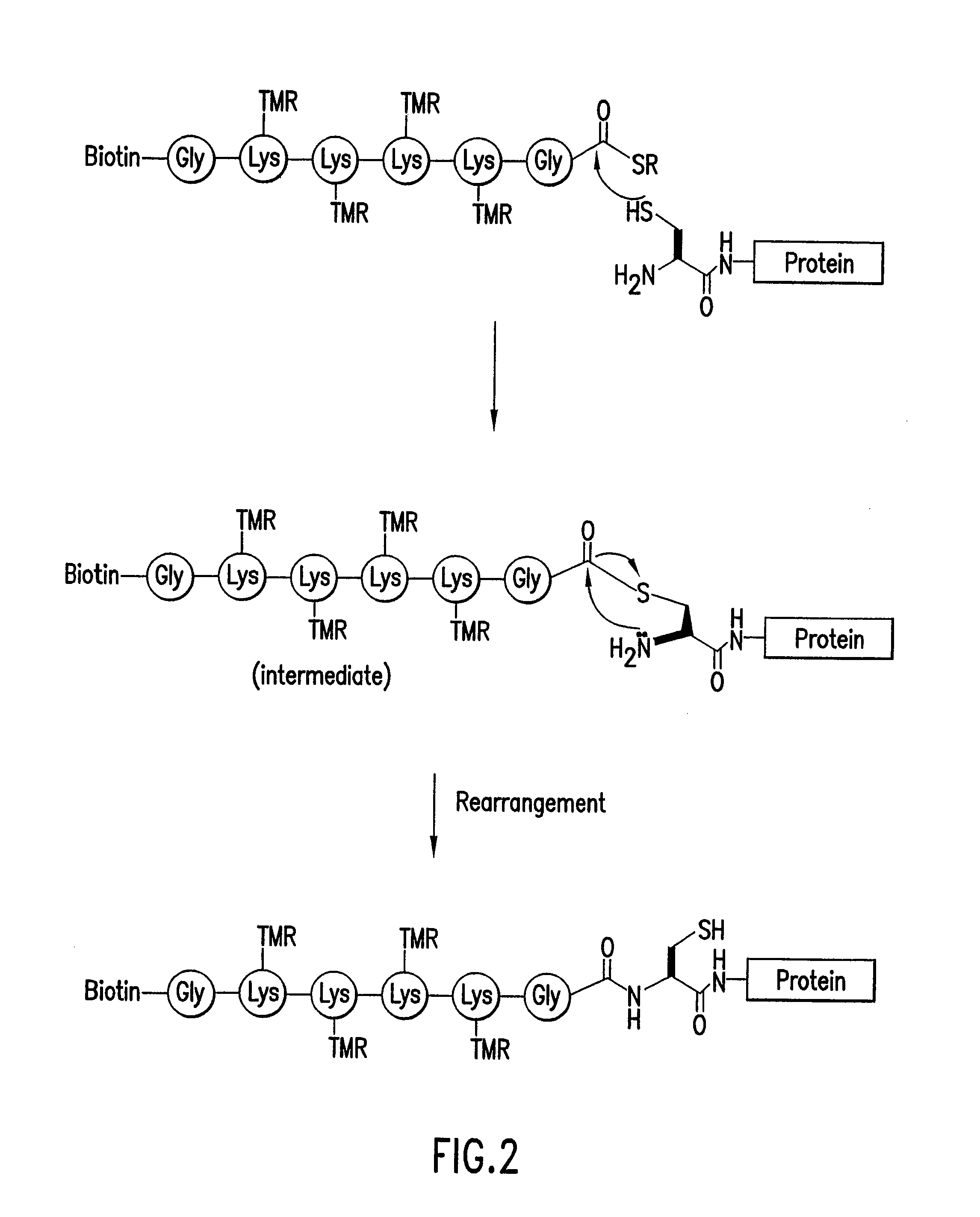Highly Homogeneous Molecular Markers for Electrophoresis
a molecular marker and electrophoresis technology, applied in the field of molecular biology and protein biochemistry, can solve the problems of ambiguous or unreliable representation of experimental data, difficult to maintain uniformity between gels, and lack of molecular marker precision, etc., to achieve the effect of increasing precision and reliability of methods
- Summary
- Abstract
- Description
- Claims
- Application Information
AI Technical Summary
Benefits of technology
Problems solved by technology
Method used
Image
Examples
example 1
Reaction of Cys-Ser-Thr-Met-Met-Ser-Arg-Ser-His-Lys-Thr-Arg-Ser-His-His-Val-OH (SEQ ID NO:2) with TMR-thioester 15 using Native Chemical Ligation
[0182]The model peptide, Cys-Ser-Thr-Met-Met-Ser-Arg-Ser-His-Lys-Thr-Arg-Ser-His-His-Val-OH (SEQ ID NO:2), was prepared by optimized stepwise solid phase peptide synthesis. The thioester 15 was prepared as outlined in FIG. 3B. To a 1 mL solution of 6.0 M guanidine hydrochloride buffered at pH 7.3 with 0.1 M sodium phosphate containing 5.0 mg (2.65×10-36 mmol) of the peptide was added 3.0 mg (1.5×10−3 mmol) of TMR-thioester 15 dissolved in 20 μL of acetonitrile. To this was added 10 μL (1%, v / v) toluenethiol and 30 μL (3%, v / v) thiophenol and stirred at room temperature under Argon overnight. Mass spectroscopy data and SDS gel electrophoresis showed that the product, TMR-labeled peptide was formed.
example 2
[0183]Cloning of Maltose Binding Protein-95aa (MBP-95aa) Gene into pTWIN1 Vector
[0184]TOPO Cloning of MBP-95aa Gene: Two restriction sites, Spe1 and Nde1, were introduced on either side of MBP-95aa gene. The PCR amplified gene was purified and TOPO-cloned into pCR-TOPO vector. The pCR-TOPOMBP-95aa gene was transformed into TOP10 competent cells and grew on LB / AMP plate overnight. Ten colonies were taken and used to inoculate ten 2-mL LB / AMP cultures (one colony / tube) and grown at 37° C. overnight. The DNA from each culture was isolated using S.N.A.P.™ (Simple Nucleic Acid Prep) Miniprep kit (Invitrogen Corporation, Carlsbad, Calif.) and analyzed by DNA sequencing.
[0185]Restriction Digestion and Ligation: The pCR-TOPOMBP-95aa was digested simultaneously with SpeI and NdeI at 37° C. overnight. The pTWIN1 vector was digested with the same enzymes. Both reaction mixtures were purified on a 1.2% agarose gel. The insertion of MBP-95aa gene into pTWIN1 plasmid was conducted at 14° C. for 3...
example 3
Synthesis of Peptides
[0197]A peptide suitable as a “Segment A” and having the following amino acid sequence: Cys-Leu-Lys(TMR)-Asp-Ala-Leu-Asp-Ala-Leu-Asp-Ala-Leu-Lys(TMR)-Asp-Ala-amide (SEQ ID NO:3), was prepared by highly optimized stepwise solid phase peptide synthesis. In a 30-mL reaction vessel fitted with a glass frit 909 mg (0.2 mmol) of Fmoc-PAL-PEG-PS resin (Applied Biosystems, 0.22 meq.) was soaked in 10 ml of 20% of piperidine / DMF solution containing 0.05 M HOBt for 5 minutes. The liquid was drained, and the same procedure was repeated 2 more times. The resin was washed with 10 ml of DMF six times. In another reaction vessel, the carboxyl group of Fmoc-Ala (249.0 mg, 0.8 mmol) was activated with of 303.0 mg (0.8 mmol) O-benzotriazol-1-yl-N,N,N′,N′-tetramethyluronium hexafluorophosphate (HBTU) in the presence of 30.0 mg (0.2 mmol) of 1-hydroxybenzotriazole (HOBT) and 280.0 μL (1.6 mmol) of N,N-diisopropylethylamine (DIEA) in 10 ml of DMF. The mixture was stirred for 3 minut...
PUM
| Property | Measurement | Unit |
|---|---|---|
| molecular weights | aaaaa | aaaaa |
| molecular weight | aaaaa | aaaaa |
| molecular weight | aaaaa | aaaaa |
Abstract
Description
Claims
Application Information
 Login to View More
Login to View More - R&D
- Intellectual Property
- Life Sciences
- Materials
- Tech Scout
- Unparalleled Data Quality
- Higher Quality Content
- 60% Fewer Hallucinations
Browse by: Latest US Patents, China's latest patents, Technical Efficacy Thesaurus, Application Domain, Technology Topic, Popular Technical Reports.
© 2025 PatSnap. All rights reserved.Legal|Privacy policy|Modern Slavery Act Transparency Statement|Sitemap|About US| Contact US: help@patsnap.com



